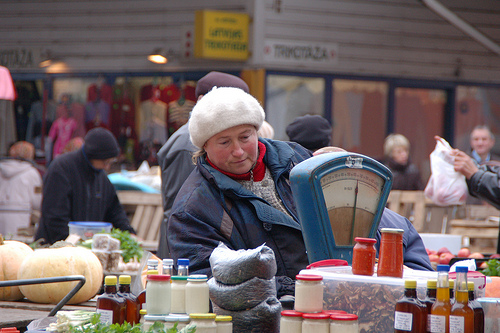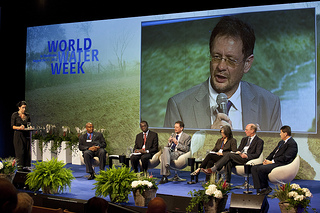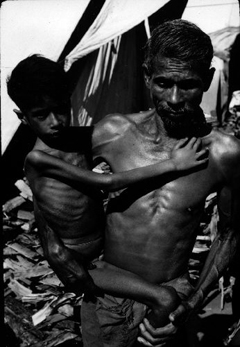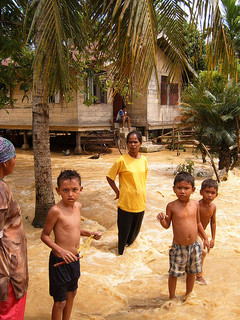Navigation
Finding Means to Meet Water and Food Needs at 2012 World Water Week
The 2012 World Water Week (WWW) in Stockholm, Sweden, organized by the Stockholm International Water Institute Stockholm (SIWI), undertook the task of addressing crucial concerns focusing on "Water and Food Security," with publications and videos prepared in advance to provide background and to stimulate conversations among the 2,500 WWW participants in order to build on knowledge what is successfully working and to advance positive action.
 Woman at food market in Riga, Latvia.: Photo credits: Jakob Granit, SIWI.
Woman at food market in Riga, Latvia.: Photo credits: Jakob Granit, SIWI.
“…once we can secure access to clean water and to adequate sanitation facilities for all people, irrespective of the difference in their living conditions, a huge battle against all kinds of diseases will be won," said the late Dr. Lee Jong-wook, when Director-General of WHO.
Meeting the need for safe water and sanitation coupled with protection of the environment and prevention of pollutants is essential to improve the health and living conditions of billions of people -- to effectively diminish the incidence of diseases that afflict a third or more of the people of the world while improving education and economic well-being and elevating billions out of vicious cycles of poverty
This goal is far from being met. 1.2 billion people are exposed to water-related illness from their drinking water. Roughly 884 million lack access to safe water, and 2.5 billion lack access to an improved sanitation facility. Poor sanitation and hygiene are inextricably linked to water quality. In most developing countries the main source of contaminated water is fecal contamination --particularly a problem where 1.1 billion people still practice open defecation. And water and sanitation-related infections are often combined with nutritional deficiencies.
 2012 High Level Panel. 2012 World Water Week.: Photograph by Thomas Henrikson. SIWIThe 2012 World Water Week (WWW) in Stockholm, Sweden, organized by the Stockholm International Water Institute Stockholm (SIWI), undertook the task of addressing these crucial concerns while focusing on "Water and Food Security," in particular, with publications and videos prepared in advance to provide background and to stimulate conversations among the 2,500 WWW participants in order to build on knowledge what is successfully working and to advance positive action.
2012 High Level Panel. 2012 World Water Week.: Photograph by Thomas Henrikson. SIWIThe 2012 World Water Week (WWW) in Stockholm, Sweden, organized by the Stockholm International Water Institute Stockholm (SIWI), undertook the task of addressing these crucial concerns while focusing on "Water and Food Security," in particular, with publications and videos prepared in advance to provide background and to stimulate conversations among the 2,500 WWW participants in order to build on knowledge what is successfully working and to advance positive action.
The Stockholm International Water Institute report "Feeding a thirsty world: Challenges and opportunities for a water and food secure world," which provided official input into the discussions at the WWW focuses on a number of “essential and largely overlooked challenges where dedicated action can help ensure food security to a growing global population with available water resources” that were addressed during the week. These include:
· Improvements in on-farm water efficiency,
· Reductions in losses and waste in the food supply chain,
· Enhanced response networks to early warning systems for agricultural emergencies, and
· Increased investment to close the gender gap in agricultural production.
The report notes that 900 million people are hungry and two billion more people are undernourished in spite of the fact that per capita production continues to increase.
Authored by a dozen experts from SIWI, the Food and Agriculture Organization of the United Nations (FAO) and the International Water Management Institute (IWMI), the report provides new evidence that shows how continuing current trends in food production could lead to increased shortages and intense competition for scarce water resources in many regions across the world.
"Feeding everyone well is a primary challenge for this century. Overeating, undernourishment and waste are all on the rise and increased food production may face future constraints from water scarcity," said report editor Dr. Anders Jägerskog. "We will need a new recipe to feed the world in the future."
What does it mean to be hungry, malnourished or undernourished?
 Extreme emaciation or Marasmus: Photograph courtesy of the U.S. CDC“Malnutrition and undernutrition remain prominent global causes of ill health and premature mortality,” writes Dr. Jeffrey K. Griffiths writes in the book Water and Sanitation Related Diseases and the Environment: Challenges, Interventions, and Preventive Measures. “These conditions contribute to high rates of mortality in children under the age of 5 and in pregnant women, as well as to morbidity in many age ranges. A recent estimate is that malnutrition contributes to the deaths of one-third of all children under the age 5. Malnutrition can kill directly, as in famine, and also indirectly, by increasing both the rate and severity of infectious diseases. Above and beyond these medical outcomes, malnutrition and undernutrition contribute to lower educational achievement, to lower physical and mental productivity, and to lower social achievement and earning power.”
Extreme emaciation or Marasmus: Photograph courtesy of the U.S. CDC“Malnutrition and undernutrition remain prominent global causes of ill health and premature mortality,” writes Dr. Jeffrey K. Griffiths writes in the book Water and Sanitation Related Diseases and the Environment: Challenges, Interventions, and Preventive Measures. “These conditions contribute to high rates of mortality in children under the age of 5 and in pregnant women, as well as to morbidity in many age ranges. A recent estimate is that malnutrition contributes to the deaths of one-third of all children under the age 5. Malnutrition can kill directly, as in famine, and also indirectly, by increasing both the rate and severity of infectious diseases. Above and beyond these medical outcomes, malnutrition and undernutrition contribute to lower educational achievement, to lower physical and mental productivity, and to lower social achievement and earning power.”
Dr. Griffiths adds that “Unsafe water and a lack of sanitation contribute to malnutrition by fostering the transmission of infectious diseases which sap nutrition through nutrient loss, malabsorption, and anorexia during the illness…Availability of clean water decreases the rates of infections such as diarrhea and hepatitis and allows hygienic behaviors such as washing hands after defecation or [before] food preparation.”
 Professor Jan Lunqvist, Senior Scientific Advisor SIWI: Photograph courtesy of SIWIProfessor Jan Lundqvist, Senior Scientific Advisor at SIWI manages international applied research projects, such as “From Field to Fork: curbing losses and wastage in the food chain.” He is involved in several international projects focusing on water, climate variability, food security and socioeconomic development options. In an interview with Janine Selendy, Chairman, President and Publisher for Horizon International, at the World Water Week in Stockholm, Professor Lundqvist discussed the close links between society and natural resources, focusing on the food, water, land-use and policy nexus.
Professor Jan Lunqvist, Senior Scientific Advisor SIWI: Photograph courtesy of SIWIProfessor Jan Lundqvist, Senior Scientific Advisor at SIWI manages international applied research projects, such as “From Field to Fork: curbing losses and wastage in the food chain.” He is involved in several international projects focusing on water, climate variability, food security and socioeconomic development options. In an interview with Janine Selendy, Chairman, President and Publisher for Horizon International, at the World Water Week in Stockholm, Professor Lundqvist discussed the close links between society and natural resources, focusing on the food, water, land-use and policy nexus.
Lundqvist stressed the need to speed up actions to address food and water needs not only to meet the current requirements to more adequately feed 7 billion people, but to prepare for feeding a population expected to reach 9 billion in just a couple decades.
 Floods in Langsa, Indonesia, 2007.: Photograph by Alastair Morrison, SIWI.Global Climate Change droughts, floods, salination of land, and ecosystem changes, among other factors will make it harder to meet the need for food. “The number of people who could be fed if we could reduce the losses and waste in the world would be tremendous,” Lundqvist added. “The current estimate about the amount of food lost and wasted is 1.3 billion tons. If we would reduce the loss and waste by 50%, it would mean we would save in the order of 650 million tons of food. Quite a lot of food….You can assure that those who have need would have access to that food then we would not have a problem with undernourishment or food insecurity.”
Floods in Langsa, Indonesia, 2007.: Photograph by Alastair Morrison, SIWI.Global Climate Change droughts, floods, salination of land, and ecosystem changes, among other factors will make it harder to meet the need for food. “The number of people who could be fed if we could reduce the losses and waste in the world would be tremendous,” Lundqvist added. “The current estimate about the amount of food lost and wasted is 1.3 billion tons. If we would reduce the loss and waste by 50%, it would mean we would save in the order of 650 million tons of food. Quite a lot of food….You can assure that those who have need would have access to that food then we would not have a problem with undernourishment or food insecurity.”
“We need strong political leadership followed up with practices,” he said. “An important aspect is that there is much better collaboration between food producers, industry and the retail sector….We as citizens need to do what we can to contribute.” And, to find answers to “How do we get good communication and good partnerships?”
“We could have a 9th Millennium Development Goal (MDG), to reduce losses and waste by 50 percent,” Lundqvist suggested.
Videos with Professor Jan Lundqvist:
In November of 2011, Prof. Jan Lundqvist addressed to the EU Parliament on Waste of Water, “stop wasting water.” His address can be seen here: http://blip.tv/world-water-week/prof-jan-lundqvist-address-to-the-eu-parliament-on-waste-of-water-5715533
In his summarizing remarks following the conclusion of World Water Week 2012, Jan Lundqvist wrote, “…a large fraction of the food produced by farmers, and especially small farmers, is lost, degraded in quality and wasted from production to the beneficial intake. This is an add-on feature to the well-known fact that a significant fraction of the grain is used to feed animals and, to a smaller extent, to produce biofuels. Food lost and wasted means misuse of the water and other resources that went into production and post-harvest operations. Although blatantly wrong in a world with finite and variable water resources and linked to a double burden of malnutrition, it is also a misuse of investments, missed opportunities of improved income for farmers and expenditure by consumers that goes down the drain.”
Several videos from World Water Week cover significant facts and ideas for action. Two more are included here. WWW videos can be accessed at SIWI’s World Water Week Youtube Channel: www.youtube.com/user/worldwaterweek.
Creating food security by fixing the leaks in the global supply chain with Dr Johan Kuylenstierna, Executive Director, Stockholm Environment Institute (SEI)
“Taste the waste of Water” A special film by filmmaker Valentin Thurn, Schnittstelle, THURN GbR, Germany in collaboration with SIWI and the Food and Agriculture Organization of the United Nations (FAO), “Taste the waste of Water.” This film highlights the issue of water and food waste.
In connection with the launch of the film at World Water Week introduced by Jan Lundqvist, a group of international thought-leaders joined the producer, SIWI and FAO in their call for action to cut waste in a joint op-ed. The full text is featured below:
FOOD WASTE – MORTGAGING OUR WATER FUTURE
No child to bed hungry
At the first World Food Conference, in Rome in 1974, Mr. Henry Kissinger made a laudable pledge, “In ten years’ time no child will go to bed hungry.” There was reason for optimism. For years, global food production increased faster than rate of population growth. The number of people suffering from undernourishment was gradually pushed back.
Widespread use of high yielding varieties of seeds, massive investments in irrigation and other arrangements for increased production contributed to tangible returns for farmers as well as for consumers. For about two decades, the green revolution meant a boost to food security and livelihoods for hundreds of millions, primarily in Asia. Still, by the mid-1990s about half a billion was reported as undernourished. From then on, the number of people going to bed hungry started to increase, again.
Big surplus of food
Paradoxically, statistical information continued to show positive figures on food production and the amounts of food available on the market. Awesome figures on increasing numbers of people who are food insecure are related to poverty. Most of the bottom one billion has limited access to the food produced. For lack of money and bargaining power, they also lack access to other basic goods and services e.g. water.
This deplorable situation is remarkable in view of the fact that an estimated 1.3 billion tons of food produced is lost and wasted, corresponding to about 170 – 180 kilos per capita, year or about a third of what is produced. Overeating provides an equally uncomfortable comparison; 1.5 billion people over age 20 are overweight and obese.
But we are not just talking about food. We are talking about THE major use of water and especially the misuse of it. On average, it takes a liter of water for each kilocalorie raised. The daily diet of a poor person, which may be in the order of 1,800 to 2,000 kcal, costs in the order of one or two tons of water, while the amount of food that the rich people demand could take five tons and more. It’s thus not just about wasting food that people need, it’s about alleviating the shortage of water and make more worthwhile uses of a limited and highly variable resource possible.
High and multiple costs for limited gain
There is thus no shortage of food but rather a surplus. Naturally, it is essential to produce enough of food for a growing and increasingly wealthy population. But if a large chunk of the produce is lost, spoiled, discarded or in other ways misused, it makes sense to broaden the perspective and identify strategies that link production and sustainable diets for a growing population.
Purely in economic terms, the value of losses and waste is estimated at about £160 billion ($250 billion or 200 billion Euros). What company with an ambition to stay in business could accept production losses of the order of one third? It is simply not sensible to throw away every third or fourth item of products that have required so much effort and resources to produce. Why should consumers and decision makers accept it? While poor households spend a significant part of their disposable income on food, expenditure on food in rich countries is currently in the order of 10 – 15% of the household budget. But spending in shops is only one of the budget items. We also pay through our tax bills. Out of the EU’s total budget of slightly less than 150 billion Euros (~ £118 billion or $187 billion) about 40% is used for agricultural policy. Subsidies, which are part of this policy tend to stimulate production irrespective of regional and global food security considerations. It is mindboggling that a conservative estimate of the economic value of the global food waste is higher than EU’s total budget and almost double the total global development assistance.
Although the economic figures are staggering, the unnecessary high toll on natural resources and environmental implications are more worrisome. All food produced has consumed water, occupied land, contributed to greenhouse gas emissions and had other environmental impacts. These are real costs that may soon prove to be unacceptable since they erode the prospects for a sound and livable future for a large part of the world’s burgeoning population.
A multiple win option at reasonable cost
It’s time for a novel and much more pragmatic approach. What if we focused on what can be achieved, NOT ONLY by producing and supplying more but by making better use of what is available? If losses and waste of food are reduced by half, the potential water savings only from irrigation would be in the order of 450 cubic kilometers globally. That is equivalent to six times the annual flow of Nile water into Lake Nasser or more than half the amount of water used by the industrial sector globally. This precious water could be better used to support aquatic and other environmental functions and also used to satisfy other urgent needs in society.
True, reduction in losses will require investments in transport, storage and improved market access, especially for small producers in poorer countries. But to not invest is also costly. The difficulties for farmers in poor areas in moving their produce to more distant markets due to a lack of safe storage and transport facilities are particularly detrimental and imply missed opportunities when they produce bumper harvests. Temporary surplus will often be lost due to pests, mold and other vagaries of nature. For the small producer to bring the surplus from a benign year to the local market only means price collapse.
The challenge is quite different in the rich parts of the world where waste at the end of the supply chain is a relatively bigger problem. Consumers play a major role in this regard but blame cannot be put on one party but rather on the interplay between farmers, consumers and food industry, retailers, restaurants and other food outlets. In the end, the burdens of the misuse of resources and the food produced are carried by the public. And we are all consumers.
Go ahead with good old pledges!
The level of global food waste and the associated consequences have reached absurd proportions. It is time to renew good old pledges. When the Food and Agriculture Organization of the United Nations, FAO, was established in 1945, it had reduction of food losses within its mandate. At the first World Food Conference, in 1974, reduction of post-harvest losses by 15% was suggested and it was agreed to bring about a 50% reduction by 1985. For various reasons the pledges have been silently disregarded and ignored.
Future starts now!
The good news is that several important actors are currently lining up in efforts to promote a resource saving society together with proper nourishment for a growing world population.
Recent initiatives are promising. For instance, reduction of food losses is an important item on FAO’s agenda. In January 2012, a resolution was passed in the EU Parliament calling upon the EU members to halve food waste by 2025 and to take measures that would prevent the generation of such waste, for instance, through the reform of date labeling. Corporate sector initiatives are welcome.
The roadmap to a reduction of food losses and waste include: investments in storage for farmers, on site processing of food, improved roads and fair market access, better packaging, negotiations and awareness raising about real cost and real value of water and food, and not least, responsible consumer behavior in a world of finite and highly variable resources.
Reducing losses and waste of food, and thus water and other resources, requires joint and coordinated actions across the supply chain, from producers to the beneficial use of the produce and in dialogue with policy makers. The future of our children and grandchildren will be different to the past and contemporary situation. In a generation, some nine billion people will be living in a world with immense opportunities but also in a world where natural resource constraints and environmental dynamics more and more affect individuals and society. One of the most tangible consequences of global warming is that the availability of water will be increasingly variable while also demand for it will increase. A prodigious waste of food is simply not a sensible option in a desirable future.
Signed by:
· Isher Judge Ahluwalia, Chairperson, Board of Governors, the Indian Council for Research on International Economic Relations (ICRIER)
· Margret Catley-Carlson, UN Secretary General Adviser and Patron of the Global Water Partnership
· Junguo Liu, Professor School of Nature Conservation, Beijing Forestry University
· Jan Lundqvist, professor, senior scientific advisor, SIWI
· Alexander Mueller, Assistant Director-General, FAO
· Julian Parfitt, Dr Principle Resource Analyst, Oakdene Hollins
· Brad Ridoutt, Principal Research Scientist, CSIRO Sustainable Agriculture Flagship
· Andrea Segré, Professor of International Agricultural Policy; Dean, Faculty of Agriculture,
· University of Bologna; President, Last Minute Market
· Valentin Thurn, filmmaker, author SCHNITTSTELLE - THURN GbR, Germany
· Mohamed Ait Kadi, President of the General Council of Agricultural Development, Morocco. And Chairing the Technical Committee at the Global Water Partnership.
The Stockholm International Water Institute Stockholm (SIWI) provided significant background material, images and videos for this article. Visit www.siwi.org for more information.
Search
Latest articles
Agriculture
- World Water Week: Healthy ecosystems essential to human health: from coronavirus to malnutrition Online session Wednesday 24 August 17:00-18:20
- World Water Week: Healthy ecosystems essential to human health: from coronavirus to malnutrition Online session Wednesday 24 August 17:00-18:20
Air Pollution
- "Water and Sanitation-Related Diseases and the Changing Environment: Challenges, Interventions, and Preventive Measures" Volume 2 Is Now Available
- Global Innovation Exchange Co-Created by Horizon International, USAID, Bill and Melinda Gates Foundation and Others
Biodiversity
- World Water Week: Healthy ecosystems essential to human health: from coronavirus to malnutrition Online session Wednesday 24 August 17:00-18:20
- Mangrove Action Project Collaborates to Restore and Preserve Mangrove Ecosystems
Desertification
- World Water Week: Healthy ecosystems essential to human health: from coronavirus to malnutrition Online session Wednesday 24 August 17:00-18:20
- UN Food Systems Summit Receives Over 1,200 Ideas to Help Meet Sustainable Development Goals
Endangered Species
- Mangrove Action Project Collaborates to Restore and Preserve Mangrove Ecosystems
- Coral Research in Palau offers a “Glimmer of Hope”
Energy
- Global Innovation Exchange Co-Created by Horizon International, USAID, Bill and Melinda Gates Foundation and Others
- Wildlife Preservation in Southeast Nova Scotia
Exhibits
- Global Innovation Exchange Co-Created by Horizon International, USAID, Bill and Melinda Gates Foundation and Others
- Coral Reefs
Forests
- NASA Satellites Reveal Major Shifts in Global Freshwater Updated June 2020
- Global Innovation Exchange Co-Created by Horizon International, USAID, Bill and Melinda Gates Foundation and Others
Global Climate Change
- World Water Week: Healthy ecosystems essential to human health: from coronavirus to malnutrition Online session Wednesday 24 August 17:00-18:20
- Mangrove Action Project Collaborates to Restore and Preserve Mangrove Ecosystems
Global Health
- World Water Week: Healthy ecosystems essential to human health: from coronavirus to malnutrition Online session Wednesday 24 August 17:00-18:20
- More than 400 schoolgirls, family and teachers rescued from Afghanistan by small coalition
Industry
- "Water and Sanitation-Related Diseases and the Changing Environment: Challenges, Interventions, and Preventive Measures" Volume 2 Is Now Available
- Global Innovation Exchange Co-Created by Horizon International, USAID, Bill and Melinda Gates Foundation and Others
Natural Disaster Relief
- STOP ATTACKS ON HEALTH CARE IN UKRAINE
- Global Innovation Exchange Co-Created by Horizon International, USAID, Bill and Melinda Gates Foundation and Others
News and Special Reports
- World Water Week: Healthy ecosystems essential to human health: from coronavirus to malnutrition Online session Wednesday 24 August 17:00-18:20
- STOP ATTACKS ON HEALTH CARE IN UKRAINE
Oceans, Coral Reefs
- World Water Week: Healthy ecosystems essential to human health: from coronavirus to malnutrition Online session Wednesday 24 August 17:00-18:20
- Mangrove Action Project Collaborates to Restore and Preserve Mangrove Ecosystems
Pollution
- Zakaria Ouedraogo of Burkina Faso Produces Film “Nzoue Fiyen: Water Not Drinkable”
- "Water and Sanitation-Related Diseases and the Changing Environment: Challenges, Interventions, and Preventive Measures" Volume 2 Is Now Available
Population
- "Water and Sanitation-Related Diseases and the Changing Environment: Challenges, Interventions, and Preventive Measures" Volume 2 Is Now Available
- "Water and Sanitation-Related Diseases and the Changing Environment: Challenges, Interventions, and Preventive Measures" Volume 2 Is Now Available
Public Health
- Honouring the visionary behind India’s sanitation revolution
- Honouring the visionary behind India’s sanitation revolution
Rivers
- World Water Week: Healthy ecosystems essential to human health: from coronavirus to malnutrition Online session Wednesday 24 August 17:00-18:20
- Mangrove Action Project Collaborates to Restore and Preserve Mangrove Ecosystems
Sanitation
- Honouring the visionary behind India’s sanitation revolution
- Honouring the visionary behind India’s sanitation revolution
Toxic Chemicals
- "Water and Sanitation-Related Diseases and the Changing Environment: Challenges, Interventions, and Preventive Measures" Volume 2 Is Now Available
- Actions to Prevent Polluted Drinking Water in the United States
Transportation
- "Water and Sanitation-Related Diseases and the Changing Environment: Challenges, Interventions, and Preventive Measures" Volume 2 Is Now Available
- Urbanization Provides Opportunities for Transition to a Green Economy, Says New Report
Waste Management
- Honouring the visionary behind India’s sanitation revolution
- Honouring the visionary behind India’s sanitation revolution
Water
- Honouring the visionary behind India’s sanitation revolution
- Honouring the visionary behind India’s sanitation revolution
Water and Sanitation
- Honouring the visionary behind India’s sanitation revolution
- Honouring the visionary behind India’s sanitation revolution

